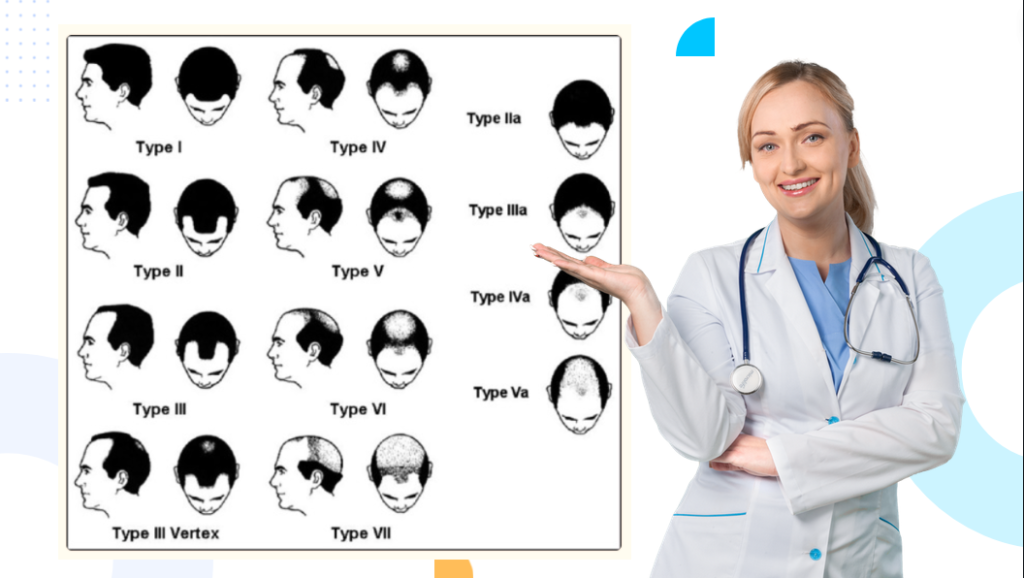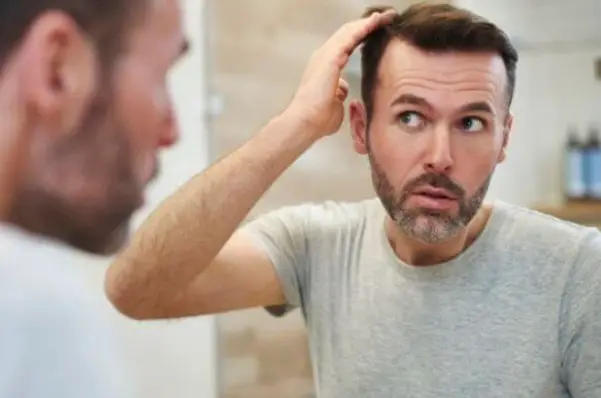Balding, a phenomenon that many men and some women encounter in their lifetime, is often misunderstood and feared. It’s a natural process that can be influenced by various factors such as genetics, hormones, and age. Understanding the stages of balding can help you anticipate the progression and explore appropriate treatment options.
In this comprehensive guide, we will delve into the world of balding, from the early signs to the advanced stages. We will also discuss the Norwood-Hamilton scale, a widely accepted classification system for male pattern baldness.
Whether you’re just noticing a receding hairline or you’re already in the advanced stages of balding, this guide will provide you with valuable insights. So, let’s embark on this journey of understanding the stages of balding.
If you’re interested in learning more about the specifics of male pattern baldness, we recommend reading our detailed article on Receding Hairline Stages. It provides a deep dive into the progression of this common type of hair loss.
Key Takeaways
Balding, or androgenetic alopecia, is a common condition that affects many people, particularly men. Here are the key takeaways from this article:
- Understanding Balding: Balding is primarily caused by genetics and hormones, specifically Dihydrotestosterone (DHT). It often starts with a receding hairline and progresses to more noticeable hair loss.
- Stages of Balding: The stages of balding are typically classified using the Norwood-Hamilton scale for men and the Ludwig scale for women. These scales help identify the pattern and severity of hair loss. For more on this, read our article on Norwood Scale: Classifying the Stages of Male Pattern Baldness.
- Treatment Options: There are various treatment options available for different stages of balding, from over-the-counter topical treatments like Minoxidil to surgical options like hair transplant surgery. The best treatment depends on the stage of balding, overall health, and personal preferences.
- FAQs About Balding: Common questions about balding include causes, early signs, reversibility, differences between men and women, and how stages are determined. For more on this, check out our Frequently Asked Questions About Balding.
- Conclusion: While balding can be a distressing experience, understanding the stages and knowing the treatment options can help manage the condition. Consult with a healthcare professional to explore the best treatment options for your specific situation.
Ready to learn more? Let’s dive in!
What is Balding?
Balding, also known as androgenic alopecia or male pattern baldness, is a common type of hair loss that affects many people worldwide. It typically manifests as a receding hairline and thinning hair on the crown of the head.
The process of balding is often gradual, occurring over several years or even decades. It’s influenced by a combination of genetic and hormonal factors. For instance, a hormone called dihydrotestosterone (DHT) plays a significant role in shrinking hair follicles, leading to the typical patterns of hair loss seen in balding.
It’s important to note that balding is not exclusive to men. Female pattern baldness, although less common, also occurs and is characterized by general hair thinning rather than a receding hairline.
Understanding the causes and risk factors of balding can help you take proactive steps to manage your hair health. If you’re noticing signs of hair loss, don’t panic. There are numerous treatment options available that can slow down the progression and even regrow hair in some cases.
To learn more about the specific patterns of hair loss in men, check out our article on Male Pattern Baldness. It provides a detailed overview of the progression of male pattern baldness.
For those interested in the differences between male and female pattern baldness, our article on Female Pattern Baldness offers a comprehensive look at this topic.
Stay tuned as we delve deeper into the stages of balding in the following sections.
The Norwood-Hamilton Scale: Classifying the Stages of Balding
When it comes to understanding the stages of balding, one of the most widely used tools is the Norwood-Hamilton scale. This classification system provides a clear framework for identifying the progression of male pattern baldness.
The Norwood-Hamilton scale is divided into seven stages, each representing a different level of hair loss:
- Stage 1: No significant hair loss or recession of the hairline.
- Stage 2: Slight recession of the hairline around the temples.
- Stage 3: The first signs of clinically significant balding appear. The hairline becomes deeply recessed at both temples, resembling an M, U, or V shape.
- Stage 4: Hairline recession is more severe than in Stage 2, and there is sparse hair or no hair on the vertex. The two areas of hair loss are separated by a band of hair that connects to the hair remaining on the sides of the scalp.
- Stage 5: The areas of hair loss are larger than in Stage 4. They are still separated, but the band of hair between them is narrower and sparser.
- Stage 6: The balding areas at the temples join with the balding area at the vertex. The band of hair across the crown is gone or sparse.
- Stage 7: The most severe stage of hair loss, only a band of hair going around the sides of the head remains. This hair is usually not dense and may be fine.
Understanding where you fall on this scale can help guide treatment decisions and set realistic expectations about outcomes.
For a more detailed look at each stage, including images and treatment options, check out our comprehensive guide on the Norwood Scale.
In the next section, we’ll discuss how to recognize the early stages of balding and why early detection is crucial for effective treatment. Stay tuned!
For those who are noticing signs of hair loss and are unsure about the stage, our article on Early Stages of Balding provides helpful insights into identifying and addressing early hair loss.
Remember, understanding your stage of balding is the first step towards effective management and treatment. So, let’s continue our journey of understanding the stages of balding.
Recognizing the Early Stages of Balding
The early stages of balding can be subtle and easy to overlook. However, early detection is crucial for slowing down the progression and potentially reversing hair loss. Here are some signs to look out for:
- Receding Hairline: One of the first signs of balding is a receding hairline, particularly around the temples. This can create an “M” shape on the forehead.
- Thinning Hair: You might notice that your hair is becoming less dense, particularly at the crown of your head. This is often more noticeable when your hair is wet or under bright light.
- Hair Fall: While it’s normal to lose a few hairs every day, excessive hair fall could be a sign of early balding. You might notice more hair on your pillow, in the shower, or on your comb.
- Changes in Hair Texture: Your hair might become finer, losing its previous thickness and volume.
If you’re noticing any of these signs, it’s important not to panic. Hair loss is a common phenomenon, and there are numerous treatment options available. The key is to act early and consult with a healthcare professional or a hair loss expert.
For more information on recognizing and addressing early hair loss, check out our detailed guide on Early Stages of Balding. It provides practical tips and advice on managing early-stage hair loss.
In the next section, we’ll delve deeper into the progression of balding, from the early stages to the advanced stages. Stay tuned as we continue to unravel the complexities of hair loss.
If you’re interested in learning more about the specific patterns of hair loss in men, we recommend reading our comprehensive article on How to Reverse Male Pattern Baldness Naturally. It provides a deep dive into the progression of this common type of hair loss.
Remember, understanding the early signs of balding is the first step towards effective management and treatment. So, let’s continue our journey of understanding the stages of balding.
Progression of Balding: From Early to Advanced Stages
Balding, or androgenetic alopecia, is a common phenomenon that affects many men as they age. It’s a process that doesn’t happen overnight but progresses gradually over time. Understanding the stages of balding can help you identify the signs early and seek appropriate treatment.
Early Stages of Balding
The early stages of balding can be subtle and often go unnoticed. The first sign is usually a receding hairline, which starts to form an “M” shape. The hair at the temples and on the crown slowly begin to thin and eventually disappear. This is often referred to as the Norwood 1 stage of balding.
During this phase, the hair follicles start to miniaturize, leading to shorter and finer strands of hair. The growth cycle for each hair begins to weaken, and no new hair grows in its place. This process is primarily driven by the male sex hormone dihydrotestosterone (DHT), which is more potent than testosterone and remains bound to the hair follicles for longer.
Intermediate Stages of Balding
As balding progresses, the hairline continues to recede, forming a clear “M” shape. This is known as the Norwood 3 stage. Some men may also start to notice thinning at the crown of the head, referred to as the vertex scalp.
During these stages, the anagen (growth) phase of the hair cycle becomes shorter, and the telogen (resting) phase becomes longer. The shortened growing phase means the hair cannot grow as long as before. Over time, the anagen phase becomes so short that the new hairs do not even peek through the surface of the skin.
Advanced Stages of Balding
In the advanced stages of balding, such as the Norwood 6 stage, the hairline continues to recede until all or most of the hair is gone. The scalp becomes more visible, and the hair on the sides and back of the head also starts to thin.
At this point, the hair follicles have become so small that they produce vellus hairs, the type of soft, light hairs that cover an infant and mostly disappear during puberty. The hair growth cycle has been significantly disrupted, leading to more hair loss.
Coping with Balding
Balding can have a significant impact on a person’s self-esteem and overall quality of life. However, various treatments are available to manage the condition. These include medications like Minoxidil and Finasteride, hair transplant surgery, and even wigs or hairpieces.
It’s important to remember that balding is a natural process and a part of aging. If you’re experiencing hair loss, it’s crucial to consult with a healthcare professional to understand the cause and explore the best treatment options for you.
Balding is a natural process, but it can be distressing for many. However, there are several ways to manage and cope with the condition.
Medical Treatments
Medical treatments like Minoxidil and Finasteride are often recommended for managing balding. Minoxidil, a topical treatment, is applied directly to the scalp to stimulate hair growth. On the other hand, Finasteride is an oral medication that inhibits the production of DHT, the hormone responsible for hair follicle shrinkage.
Hair Transplant Surgery
Hair transplant surgery is another option for those experiencing advanced stages of balding. This procedure involves transplanting hair follicles from one part of the scalp to the balding areas. It’s a more permanent solution but can be costly and requires recovery time.
Wigs or Hairpieces
For some, wigs or hairpieces may be a suitable option. They provide an immediate solution to hair loss and come in various styles and colors to match natural hair.
Lifestyle Changes
Lifestyle changes can also help manage balding. This includes maintaining a balanced diet, reducing stress, and avoiding hairstyles that pull on the hair, like tight ponytails or braids.
Balding is a part of life for many men, but it doesn’t have to define you. Remember, it’s not the hair on your head but the life you lead that truly matters. If you’re experiencing hair loss, consult with a healthcare professional to understand the cause and explore the best treatment options for you.
For more information on the stages of balding, check out these related articles:
- Norwood 0: The Beginning of the Journey
- Late Stage Traction Alopecia: Understanding the Causes
- Male Pattern Baldness Stages Over Time: A Detailed Overview
Treatment Options for Different Stages of Balding
Balding is a common issue that affects many people, especially men. The process of balding can be slow and gradual, often starting with a receding hairline and progressing to more noticeable hair loss. The good news is that there are various treatment options available for different stages of balding.
Early Stage Treatments
In the early stages of balding, when hair loss is minimal, treatments aim to slow down or stop the progression.
- Minoxidil: This over-the-counter topical treatment is applied directly to the scalp to stimulate hair follicles and promote growth. It’s most effective in the early stages of hair loss.
- Finasteride: This prescription medication works by inhibiting the production of DHT, a hormone that contributes to hair loss. It’s often used in combination with Minoxidil for best results.
- Healthy Lifestyle: Maintaining a balanced diet, getting regular exercise, and managing stress can also help slow down hair loss.
For more information on early stage treatments, check out our article on Early Stages of Balding Crown: What to Look For.
Related Post:
- Stage 1 Hair Loss Treatment: Causes, Solutions, and FAQs
Mid-Stage Treatments
As balding progresses, more aggressive treatments may be necessary.
- Low-Level Laser Therapy (LLLT): This non-invasive treatment uses light energy to stimulate hair growth. It’s often used in conjunction with other treatments like Minoxidil and Finasteride.
- Platelet-Rich Plasma (PRP) Therapy: PRP involves injecting your own blood plasma into your scalp to stimulate hair growth. It’s a promising treatment for those in the mid-stages of balding.
For a deeper understanding of mid-stage treatments, read our article on Male Pattern Baldness Stages and Time.
Advanced Stage Treatments
In the advanced stages of balding, when hair loss is significant, surgical options may be considered.
- Hair Transplant Surgery: This procedure involves moving hair follicles from a part of your scalp where hair is still growing to the balding areas. It’s a more permanent solution but can be costly and requires recovery time.
- Scalp Micropigmentation (SMP): SMP is a non-surgical treatment that uses tiny tattoos to create the appearance of a fuller head of hair. It’s a good option for those who are comfortable with a shaved head look.
For more on advanced stage treatments, visit our article on Norwood Scale: Classifying the Stages of Male Pattern Baldness.
Remember, the best treatment for you depends on your individual circumstances, including the stage of your balding, your overall health, and your personal preferences. Always consult with a healthcare professional before starting any new treatment.
For more information on balding and its stages, check out our comprehensive guide on crown balding stages.
Frequently Asked Questions About Balding
Balding is a topic that raises many questions. Here are some of the most frequently asked questions about balding, along with their answers.
What causes balding?
Balding, also known as androgenetic alopecia, is primarily caused by genetics and hormones. Dihydrotestosterone (DHT), a hormone derived from testosterone, is believed to cause hair follicles to shrink and eventually stop producing hair.
What are the early signs of balding?
Early signs of balding include a receding hairline, thinning hair on the crown of the head, and losing more hair than usual when brushing or showering. For more on this, read our article on Early Stages of Balding Crown: What to Look For.
Can balding be reversed?
While balding cannot be completely reversed, its progression can be slowed or even stopped with treatments like Minoxidil, Finasteride, and low-level laser therapy. In some cases, hair transplant surgery can help restore hair in balding areas.
Is balding the same in men and women?
While both men and women can experience balding, the pattern and progression often differ. Men typically experience a receding hairline and balding on the crown, while women usually experience overall thinning without a receding hairline. For more on this, check out our article on Ludwig Pattern Hair Loss: A Guide for Women.
How is the stage of balding determined?
The stage of balding is typically determined using the Norwood-Hamilton scale for men and the Ludwig scale for women. These scales classify the stages of hair loss based on patterns and severity. For more on this, visit our article on Norwood Scale: Classifying the Stages of Male Pattern Baldness.
Remember, if you’re experiencing hair loss, it’s important to consult with a healthcare professional to understand the cause and explore the best treatment options for you.
Conclusion
Balding is a common occurrence that affects many people, particularly men. Understanding the stages of balding can help you identify the signs early and seek appropriate treatment. While balding can be a distressing experience, remember that it’s a natural part of aging for many individuals and there are numerous treatment options available to manage it.
Whether you’re in the early stages of a receding hairline or dealing with more advanced hair loss, it’s important to consult with a healthcare professional to explore the best treatment options for your specific situation. From topical treatments like Minoxidil to surgical options like hair transplant surgery, there’s a range of solutions that can slow down hair loss, stimulate hair growth, or restore hair in balding areas.
Remember, everyone’s experience with balding is unique. What works for one person may not work for another. It’s all about finding the right solution for you.
- AI Powered Bald Filter Online 2024: See Yourself with No Hair! - January 19, 2024
- Harklinikken Bad Reviews 2024: Analyzing Negative Feedbacks - January 18, 2024
- How to Get the Alex Eubank Hair | Step-By-Step Tutorial 2024 - January 18, 2024







